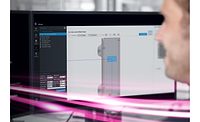Wire Processing
Rittal Releases Wire Terminal WT C Machine

Image courtesy of Rittal
Rittal North America has introduced a new wire processing machine—the Wire Terminal WT C machine. The machine enables wires to be processed from bulk with individual printing (black, white and light blue) and then ready for assembly. The core advantages of the Wire Terminal WT C are the variety of combinations, different wire output methods and support for downstream, digitally and automated processes such as labeling, sorting and transport.
Structurally, the modular system of the WT C is individually adaptable and expandable in terms of both hard and software. This enables panel builders and control manufacturer to meet future requirements. Rittal states the payback period is only 2.5 years for 300 enclosures per year.
The company states wiring in panel-building and control manufacturing is time-consuming—taking up up about 50% of processing time. So, speeding up assembly and wire processes is important within the competitive manufacturing landscape. Rittal says the Wire Terminal WT C is a solution that will aid manufacturers in cutting costs and maintaining quality with process streamlining and future flexibility in mind. The machine offers flexible configurations, quick-change system for wire, process reliability, three wire out-put methods, and a digital support for processing. In addition, it’s available in two versions and flexible configuration stages.
As an entry-level wire processing solution, Rittal offers the WT C5 variant with five vibratory bowl feeders for wire-end ferrules and wire-end treatment feature for wire with cross-sections ranging from 0.5 to 2.5 sq. mm. The product also cuts to length, labels and crimps. The WT C10 variant has 10 vibratory bowl feeders for wire-end ferrules with wire cross-sections up to 6 sq. mm.
Offering a reportedly safer process to input loose wire end ferrules and easy refill, the WT C10 allows for flexibility and less set-up effort for the wire end-treatment. The new crimper allows processing of wire end ferrule lengths ranging from 8 to 10 mm. Manufacturers are able to choose either step-less partial and full stripping up to 20 mm. when stripping the wires. Powered by servomotor technology, the crimper maintains consistency in processing quality.
The fully automated machine is operated using a 24” display and offers many improvements and innovations, such as when feeding and outputting the wires. With a new type of feeding system, the WT C10 enables fast changeover to other wires. The wire feeding system features three feed blocks for up to 36 wires and 12 wire types per feed block. A quick-change system allows the feed blocks to be set up and changed flexibly. A radio frequency identification (RFID) transponder automatically secures the wire feed which makes it easy to change complete wire magazines.
Depending on the requirements, the wires can be dispensed in a machine in three different ways: through injection, by rail system or via a chain bundler. The patented rail system can hold up to 2,100 wires. Pre-assembled wires are produced in wire rails as standard, depending on the order—enabling the lined-up wires to be processed efficiently. Chain bundles can also be produced to make the wiring process efficient as wires are arranged sequentially in the order chosen. This also allows companies to be flexible service providers as the Wire Terminal’s three flexible output options can be implemented. Combined with the software application, EPLAN Smart Wiring, and the additional process step of enclosure wiring, Rittal states this results in increased value.
Rittal also supports downstream processes with consistent data that enables efficient production. The company’s new software architecture ensure a seamless integration into the RiPanel Processing Center job management software’s data workflow. Production becomes an even stronger part of the digitally supported process chain—centrally planned and controlled with data directly from the Eplan and Rittal engineering and manufacturing ecosystem, the company concludes.
Looking for a reprint of this article?
From high-res PDFs to custom plaques, order your copy today!




